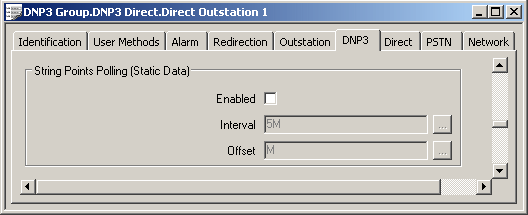Use the fields within the String Points Polling section of the DNP3 tab to specify whether ClearSCADA is to scan an outstation for static String point data:

- Enabled—Use this check box to specify whether ClearSCADA polls the outstation for String point data.
- String point data is not returned in the normal Class 0 - Integrity poll of the outstation. Select the Enabled check box for ClearSCADA to periodically issue polls to the outstation, requesting static data for the outstation’s String points. The outstation will respond by sending any static String point data that is stored in its internal buffer(s).
- Clear the check box if the outstation does not have any String points, or you do not want ClearSCADA to poll all of the outstation’s String points on a regular basis.
- Interval—Specify how often ClearSCADA polls the outstation for static String point data. Such polls may result in large quantities of data being returned to ClearSCADA. If an outstation has a large number of String points, carefully consider the frequency with which ClearSCADA should poll the outstation for String data. Depending on link speed, you should specify an interval of several minutes or hours for those outstations that have a large number of string points. Enter the time in the OPC Time Format, for example 5M (for five minutes). You can enter the value directly in the field, or use the Interval Window (accessed via the field’s browse button) to specify the required value.
- We recommend that you specify a full division of, for instance, a minute, or hour, so that polling times are consistent (for example, at 5- or 10-minute intervals).
- Offset—Specify the time offset of each poll. ClearSCADA uses the values in the Offset and Interval fields to assess how the polls are to be staggered.
- Enter the time in the OPC Relative Time Format. You can enter the value directly in the field, or use the Offset Window (accessed via the field’s browse button) to specify the required offset.